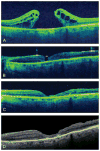Optical coherence tomography-guided facedown positioning for macular hole surgery
- PMID: 23343822
- PMCID: PMC3758113
- DOI: 10.1097/IAE.0b013e318263d0e8
Optical coherence tomography-guided facedown positioning for macular hole surgery
Abstract
Purpose: To use spectral domain optical coherence tomography-guided duration of facedown positioning to study anatomical macular hole closure rates.
Methods: Retrospective review of patients with macular holes undergoing 23-gauge pars plana vitrectomy and intraocular gas tamponade. Spectral domain optical coherence tomography imaging was done on postoperative Day 1. Patients remained facedown for 2 more days if the macular hole was closed or 6 more days facedown if the macular hole was open or indeterminate.
Results: There were 8 Stage 2, 12 Stage 3, and 12 Stage 4 macular holes. On postoperative Day 1, 24 holes were closed by spectral domain optical coherence tomography and instructed to remain facedown for two more days. Twenty-three of 24 holes remained closed during the postoperative period. Eight holes were open or indeterminate on postoperative Day 1 and remained facedown for 6 more days. Six of 8 holes (75%) were closed at their last follow-up. The overall closure rate was 29/32 (90.6%). Average follow-up was 334 days.
Conclusion: Confirming early closure of macular holes with spectral domain optical coherence tomography imaging can serve as an important guide to significantly shorten the duration of prone positioning while maintaining high closure rates.
Conflict of interest statement
The authors declare no conflict of interest.
Figures






Similar articles
-
FACEDOWN POSITIONING AFTER VITRECTOMY WILL NOT FACILITATE MACULAR HOLE CLOSURE BASED ON SWEPT-SOURCE OPTICAL COHERENCE TOMOGRAPHY IMAGING IN GAS-FILLED EYES: A Prospective, Randomized Comparative Interventional Study.Retina. 2019 Dec;39(12):2353-2359. doi: 10.1097/IAE.0000000000002325. Retina. 2019. PMID: 30204729 Clinical Trial.
-
CLOSURE OF SMALL MACULAR HOLES USING VITRECTOMY SURGERY WITH INTERNAL LIMITING MEMBRANE PEELING WITHOUT THE USE OF INTRAOCULAR GAS TAMPONADE: BROADENING THE UNDERSTANDING OF THE MACULAR HOLE PATHOPHYSIOLOGY.Retin Cases Brief Rep. 2020 Spring;14(2):104-109. doi: 10.1097/ICB.0000000000000919. Retin Cases Brief Rep. 2020. PMID: 31469775
-
Individualized, spectral domain-optical coherence tomography-guided facedown posturing after macular hole surgery: minimizing treatment burden and maximizing outcome.Retina. 2014 Jul;34(7):1367-75. doi: 10.1097/IAE.0000000000000087. Retina. 2014. PMID: 24955569
-
Facedown Positioning in Macular Hole Surgery: A Systematic Review and Individual Participant Data Meta-Analysis.Ophthalmology. 2025 Feb;132(2):194-205. doi: 10.1016/j.ophtha.2024.08.012. Epub 2024 Aug 13. Ophthalmology. 2025. PMID: 39147105
-
TOPICAL CARBONIC ANHYDRASE INHIBITORS CLOSING BILATERAL SECONDARY MACULAR HOLES AND A REVIEW OF LITERATURE.Retin Cases Brief Rep. 2024 Nov 1;18(6):683-686. doi: 10.1097/ICB.0000000000001469. Retin Cases Brief Rep. 2024. PMID: 37582334 Review.
Cited by
-
Assessment of Macular Hole Closure Speed Using Trans-tamponade OCT and 3-Dimensional Macular Hole Segmentation in the DISCOVER Study.J Vitreoretin Dis. 2024 Jul 28;8(5):558-564. doi: 10.1177/24741264241263172. eCollection 2024 Sep-Oct. J Vitreoretin Dis. 2024. PMID: 39318985 Free PMC article.
-
Wide-field laser ophthalmoscopy for imaging of gas-filled eyes after macular hole surgery.Clin Ophthalmol. 2016 Aug 24;10:1623-30. doi: 10.2147/OPTH.S109900. eCollection 2016. Clin Ophthalmol. 2016. PMID: 27601877 Free PMC article.
-
Clinical outcomes with large macular holes using the tiled transplantation internal limiting membrane pedicle flap technique.Int J Ophthalmol. 2019 Feb 18;12(2):246-251. doi: 10.18240/ijo.2019.02.10. eCollection 2019. Int J Ophthalmol. 2019. PMID: 30809480 Free PMC article.
-
Macular Hole Surgery with Internal Limiting Membrane Peeling Facilitated by Membrane-Blue® versus Membrane-Blue-Dual®: A Retrospective Comparative Study.J Ophthalmol. 2016;2016:1292735. doi: 10.1155/2016/1292735. Epub 2016 Dec 5. J Ophthalmol. 2016. PMID: 28050275 Free PMC article.
-
Minification of fundus optical coherence tomographic images in gas-filled eye.BMC Ophthalmol. 2016 Jul 26;16:124. doi: 10.1186/s12886-016-0306-1. BMC Ophthalmol. 2016. PMID: 27457372 Free PMC article.
References
-
- Kelly NE, Wendel RT. Vitreous surgery for idiopathic macular holes. Results of a pilot study. Arch Ophthalmol. 1991;109:654–659. - PubMed
-
- Wendel RT, Patel AC, Kelly NE, et al. Vitreous surgery for macular holes. Ophthalmology. 1993;100:1671–1676. - PubMed
-
- Tornambe PE, Poliner LS, Grote K. Macular hole surgery without face-down positioning. A pilot study Retina. 1997;17:179–185. - PubMed
-
- Mittra RA, Kim JE, Han DP, Pollack JS. Sustained postoperative face-down positioning is unnecessary for successful macular hole surgery. Br J Ophthalmol. 2009;93:664–666. - PubMed
-
- Dhawahir-Scala FE, Maino A, Saha K, et al. To posture or not to posture after macular hole surgery. Retina. 2008;28:60–65. - PubMed
Publication types
MeSH terms
Substances
Grants and funding
LinkOut - more resources
Full Text Sources
Other Literature Sources
Miscellaneous

